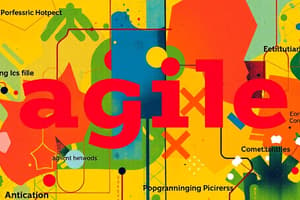Podcast
Questions and Answers
What are the main differences between Agile and Waterfall development models?
What are the main differences between Agile and Waterfall development models?
Agile is an iterative approach that promotes flexibility and collaboration, while Waterfall is a sequential process requiring each phase to complete before the next begins.
What role does a Database Management System (DBMS) play in database management?
What role does a Database Management System (DBMS) play in database management?
A DBMS serves as the software that interacts with end-users and applications to manage and organize data in databases.
Explain the concept of normalization in database management.
Explain the concept of normalization in database management.
Normalization is the process of organizing data to minimize redundancy and enhance data integrity.
How do IaaS, PaaS, and SaaS differ in cloud computing?
How do IaaS, PaaS, and SaaS differ in cloud computing?
What is a hybrid cloud, and what benefits does it offer?
What is a hybrid cloud, and what benefits does it offer?
Flashcards are hidden until you start studying
Study Notes
Information Technology Study Notes
Software Development
- Definition: The process of designing, coding, testing, and maintaining software applications.
- Key Models:
- Waterfall: Sequential design process; each phase must be completed before the next begins.
- Agile: Iterative approach; promotes flexible responses to change and collaboration.
- DevOps: Integrates development and operations to improve deployment frequency and service reliability.
- Programming Languages: Common languages include Java, Python, C#, and JavaScript.
- Development Methodologies:
- Scrum: Agile framework for managing complex projects with iterative progress.
- Extreme Programming (XP): Emphasizes technical excellence and frequent releases.
- Version Control: Tools like Git are used for tracking changes in software code.
Database Management
- Definition: The systematic organization and management of data in databases.
- Key Components:
- DBMS (Database Management System): Software that interacts with end-users, applications, and the database.
- Data Models: Structures for organizing data (e.g., relational, NoSQL).
- Normalization: Process of organizing data to reduce redundancy and improve integrity.
- SQL (Structured Query Language): Standard language for managing and manipulating relational databases.
- Backup and Recovery: Strategies to prevent data loss; includes regular backups and disaster recovery planning.
Cloud Computing
- Definition: Delivery of computing services over the internet, allowing on-demand access to resources.
- Service Models:
- IaaS (Infrastructure as a Service): Provides virtualized computing resources over the internet (e.g., AWS EC2).
- PaaS (Platform as a Service): Offers hardware and software tools over the internet (e.g., Google App Engine).
- SaaS (Software as a Service): Delivers software applications over the internet (e.g., Microsoft Office 365).
- Deployment Models:
- Public Cloud: Services offered over the public internet, available to anyone.
- Private Cloud: Exclusive use by a single organization, can be managed internally or by third parties.
- Hybrid Cloud: Combination of public and private clouds, allowing data and applications to be shared.
- Benefits:
- Scalability: Resources can be adjusted based on demand.
- Cost Efficiency: Reduces the need for on-site hardware and maintenance.
- Accessibility: Services can be accessed from anywhere with internet connectivity.
Software Development
- Process involves designing, coding, testing, and maintaining software applications.
- Waterfall Model: Features a linear progression where each phase must be completed before the next starts.
- Agile Model: Focuses on iterative development, promoting flexibility and collaboration among team members.
- DevOps: Combines development and operations to enhance deployment speed and reliability of services.
- Common programming languages include Java, Python, C#, and JavaScript.
- Scrum: An Agile framework that manages complex projects by incorporating iterative progress and sprints.
- Extreme Programming (XP): Prioritizes technical excellence and encourages frequent software releases.
- Version Control: Systems like Git are essential for tracking changes in code over time.
Database Management
- Involves the systematic organization and handling of data within databases.
- DBMS (Database Management System): Software facilitating interaction between users, applications, and databases.
- Data Models: Frameworks for data organization, including relational and NoSQL models.
- Normalization: A method aimed at reducing data redundancy and enhancing data integrity.
- SQL (Structured Query Language): The standard language used for manipulating and managing relational databases.
- Backup and Recovery: Key strategies for data preservation involving regular backups and comprehensive disaster recovery plans.
Cloud Computing
- Refers to the distribution of computing services via the internet, providing on-demand resource access.
- IaaS (Infrastructure as a Service): Offers virtualized computing resources, exemplified by AWS EC2.
- PaaS (Platform as a Service): Supplies tools and frameworks for application development online, such as Google App Engine.
- SaaS (Software as a Service): Delivers software applications through the internet, with examples like Microsoft Office 365.
- Public Cloud: Services accessible over the public internet and available to any user.
- Private Cloud: Exclusively used by a single organization, with management done either internally or by a third party.
- Hybrid Cloud: Combines features of public and private clouds, enabling data and application sharing between environments.
- Key benefits include scalability for adjusting resources based on demand, cost efficiency reducing on-site hardware needs, and accessibility allowing services to be utilized from anywhere with internet access.
Studying That Suits You
Use AI to generate personalized quizzes and flashcards to suit your learning preferences.




